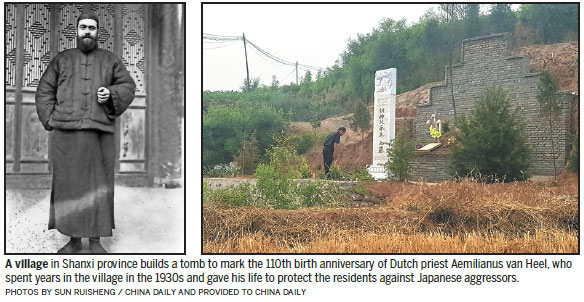

The tomb of Aemilianus van Heel located on top of a small hill in Shitou Geda village, Yuanqu, North China's Shanxi province, overlooks a patch of a wheat field he reclaimed from the wild in the 1930s.
The newly built white-marble tombstone, which looks conspicuous against the Loess Plateau, is 310 centimeters tall, representing the 31 years of the Franciscan missionary's life. He was from Leiden in the Netherlands, and known as Father Hu Yongsheng among locals.
This year marks the 110th birth anniversary of Van Heel.
The residents of Shitou Geda regard him as a family member, who is still alive, residing on the hill, and a patron saint of their hometown.
The Imperial Japanese Army invaded the Yuanqu county on Sept 13, 1938. Then, more than 2,000 refugees hid in the Catholic church in Shitou Geda.
Van Heel sat at a table in front of the church to prevent the Japanese troops from harassing those inside at the time.
On Oct 8, the Japanese army broke into the church hunting for women. But he threw a Japanese soldier out of the church, just like an "eagle catching a little chicken", many senior villagers say.
The furious Japanese soldiers then sent him an ultimatum demanding he hand over 20 young women and 10 cattle to them.
Van Heel is believed to have replied: "You can take my mule. There are no cattle in the church. As long as I am here, you will not get a single woman from the church."
The villagers found him lying in a pool of blood in his bedroom the next morning. It is believed that he was murdered that night with two shots in the chest and a deep cut on each of his wrists.
The Japanese army claimed he had committed suicide.
The refugees then buried his body in the church yard and fled, leaving his assistants who hid a fleeing Kuomintang general Gao Guizi two years later from the Japanese army, after Gao was defeated in a battle in the region.
Gao Shijie, the daughter of Gao Guizi, funded the renovation of the tomb and the building of a new tombstone to remember Van Heel's sacrifice and the assistance to her father.
According to Hu Lianying, a villager in her late 80s, Father Hu also had a sense of humor. "He once joked with me: 'Hey, little girl. We are from the same family. You see. We share the same family name Hu'."
Hu Lianying says Father Hu missed his parents in the Netherlands very much, and often looked at their photos, which he also showed to local residents.
The village's residents also say that Father Hu was a good doctor as well.
He treated patients for free. And he also raised a dozen of orphans, some of whom are still alive.
Gao Shijie says in her statement on the renovation of his tomb: "Although Father Hu had no offspring, and his heroic behavior is unknown in his motherland, we, the survivors of the War of Resistance Against Japanese Aggression (1931-45) are his successors if we can emulate his spirit of self-sacrifice."
The Dutch people did not know about Father Hu until 1990, when a local villager in Shitou Geda, Song Minhui, wrote a letter to the Dutch embassy in Beijing.
The then-Dutch ambassador Roland van den Berg wrote to Song appreciating his account of the young Dutch priest and the embassy translated Song's letter into English to let the Dutch people know about Father Hu.
The Dutch foreign ministry also then assigned a professor to investigate his early life. He found that there were no relatives alive, but a bishop then aged 94 who had known Father Hu remembered his story and said: "He was a brave and courageous man."
Van Heel was born in 1907 in Leiden, and came to China in 1933.
He learned Chinese in Luzhou, Shanxi, before joining the Shitou Geda Catholic church in 1936.
The church, which was built by Western missionaries in 1917, operated schools for boys and girls. And he was the third priest to be posted to the area.
The church was shut in 1949, and was demolished in 1985 to provide building materials for public infrastructure in the county.
The church was reopened in 1986 in caves neighboring the old site of the church.
In his statement marking the renovation of the tomb, the former Dutch ambassador writes: "It is with great satisfaction that now - 110 years after his birth - a fitting memorial has been established to remember this courageous Dutchman, who gave his life to protect the Chinese people against a foreign aggressor. It marks another proud page in the long history of the relations between the people of China and the Netherlands."
Le Yongyue, the current priest in the church, who has been working there for 19 years, often goes to the hill to sweep the tomb.
He say: "Father Hu gave his life to protect the Chinese people. He is a role model for me."
Contact the writers through liyang@chinadaily.com.cn

(China Daily 07/21/2017 page18)